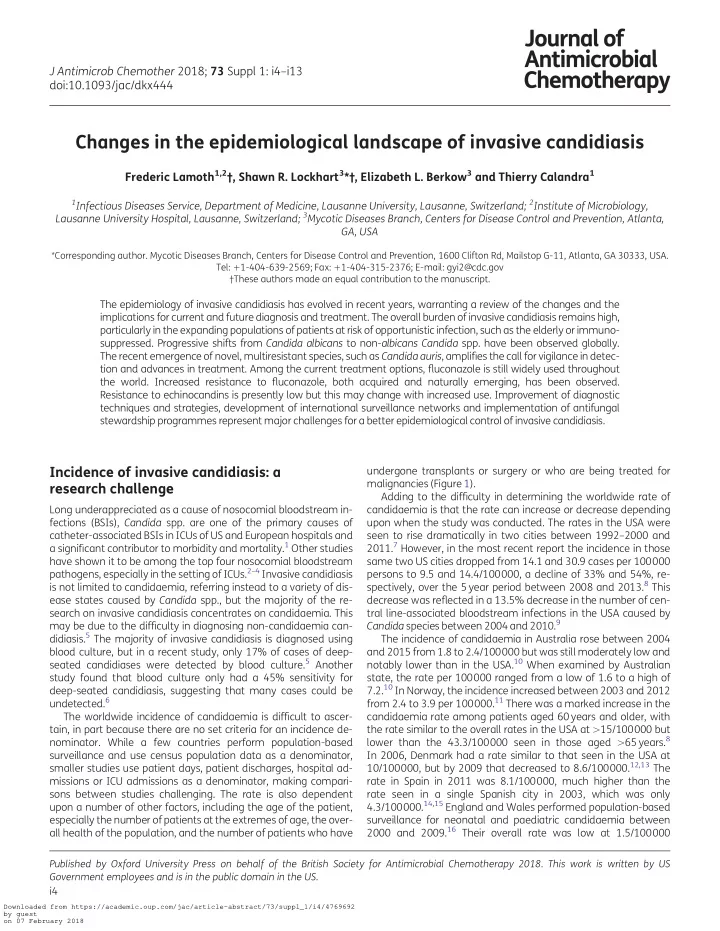

J Antimicrob Chemother 2018; 73 Suppl 1: i4–i13 doi:10.1093/jac/dkx444 Changes in the epidemiological landscape of invasive candidiasis Frederic Lamoth 1,2 †, Shawn R. Lockhart 3 *†, Elizabeth L. Berkow 3 and Thierry Calandra 1 1 Infectious Diseases Service, Department of Medicine, Lausanne University, Lausanne, Switzerland; 2 Institute of Microbiology, Lausanne University Hospital, Lausanne, Switzerland; 3 Mycotic Diseases Branch, Centers for Disease Control and Prevention, Atlanta, GA, USA *Corresponding author. Mycotic Diseases Branch, Centers for Disease Control and Prevention, 1600 Clifton Rd, Mailstop G-11, Atlanta, GA 30333, USA. Tel: ! 1-404-639-2569; Fax: ! 1-404-315-2376; E-mail: gyi2@cdc.gov †These authors made an equal contribution to the manuscript. The epidemiology of invasive candidiasis has evolved in recent years, warranting a review of the changes and the implications for current and future diagnosis and treatment. The overall burden of invasive candidiasis remains high, particularly in the expanding populations of patients at risk of opportunistic infection, such as the elderly or immuno- suppressed. Progressive shifts from Candida albicans to non- albicans Candida spp. have been observed globally. The recent emergence of novel, multiresistant species, such as Candida auris , amplifies the call for vigilance in detec- tion and advances in treatment. Among the current treatment options, fluconazole is still widely used throughout the world. Increased resistance to fluconazole, both acquired and naturally emerging, has been observed. Resistance to echinocandins is presently low but this may change with increased use. Improvement of diagnostic techniques and strategies, development of international surveillance networks and implementation of antifungal stewardship programmes represent major challenges for a better epidemiological control of invasive candidiasis. Incidence of invasive candidiasis: a undergone transplants or surgery or who are being treated for malignancies (Figure 1). research challenge Adding to the difficulty in determining the worldwide rate of Long underappreciated as a cause of nosocomial bloodstream in- candidaemia is that the rate can increase or decrease depending fections (BSIs), Candida spp. are one of the primary causes of upon when the study was conducted. The rates in the USA were catheter-associated BSIs in ICUs of US and European hospitals and seen to rise dramatically in two cities between 1992–2000 and a significant contributor to morbidity and mortality. 1 Other studies 2011. 7 However, in the most recent report the incidence in those have shown it to be among the top four nosocomial bloodstream same two US cities dropped from 14.1 and 30.9 cases per 100000 pathogens, especially in the setting of ICUs. 2–4 Invasive candidiasis persons to 9.5 and 14.4/100000, a decline of 33% and 54%, re- spectively, over the 5 year period between 2008 and 2013. 8 This is not limited to candidaemia, referring instead to a variety of dis- ease states caused by Candida spp., but the majority of the re- decrease was reflected in a 13.5% decrease in the number of cen- search on invasive candidiasis concentrates on candidaemia. This tral line-associated bloodstream infections in the USA caused by Candida species between 2004 and 2010. 9 may be due to the difficulty in diagnosing non-candidaemia can- didiasis. 5 The majority of invasive candidiasis is diagnosed using The incidence of candidaemia in Australia rose between 2004 blood culture, but in a recent study, only 17% of cases of deep- and 2015 from 1.8 to 2.4/100000 but was still moderately low and seated candidiases were detected by blood culture. 5 Another notably lower than in the USA. 10 When examined by Australian study found that blood culture only had a 45% sensitivity for state, the rate per 100000 ranged from a low of 1.6 to a high of 7.2. 10 In Norway, the incidence increased between 2003 and 2012 deep-seated candidiasis, suggesting that many cases could be from 2.4 to 3.9 per 100000. 11 There was a marked increase in the undetected. 6 The worldwide incidence of candidaemia is difficult to ascer- candidaemia rate among patients aged 60years and older, with tain, in part because there are no set criteria for an incidence de- the rate similar to the overall rates in the USA at . 15/100000 but lower than the 43.3/100000 seen in those aged . 65years. 8 nominator. While a few countries perform population-based surveillance and use census population data as a denominator, In 2006, Denmark had a rate similar to that seen in the USA at 10/100000, but by 2009 that decreased to 8.6/100000. 12,13 The smaller studies use patient days, patient discharges, hospital ad- missions or ICU admissions as a denominator, making compari- rate in Spain in 2011 was 8.1/100000, much higher than the sons between studies challenging. The rate is also dependent rate seen in a single Spanish city in 2003, which was only 4.3/100000. 14,15 England and Wales performed population-based upon a number of other factors, including the age of the patient, especially the number of patients at the extremes of age, the over- surveillance for neonatal and paediatric candidaemia between 2000 and 2009. 16 Their overall rate was low at 1.5/100000 all health of the population, and the number of patients who have Published by Oxford University Press on behalf of the British Society for Antimicrobial Chemotherapy 2018. This work is written by US Government employees and is in the public domain in the US. i4 Downloaded from https://academic.oup.com/jac/article-abstract/73/suppl_1/i4/4769692 by guest on 07 February 2018
Recommend
More recommend